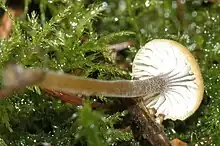| Rickenella | |
|---|---|
 | |
| Rickenella swartzii | |
| Scientific classification | |
| Kingdom: | |
| Division: | |
| Class: | |
| Order: | |
| Family: | |
| Genus: | Rickenella Raithelh. (1973) |
| Type species | |
| Rickenella fibula (Bull.) Raithelh. (1973) | |
| Species | |
|
R. alexandri | |
Rickenella is a genus of brightly colored bryophilous agarics in the Hymenochaetales that have an omphalinoid morphology.[1][2][3][4] They inhabit mosses on mossy soils, peats, tree trunks and logs in temperate regions of both the Northern and Southern Hemispheres. Phylogenetically related agarics are in the genera Contumyces, Gyroflexus, Loreleia, Cantharellopsis and Blasiphalia, as well as the stipitate-stereoid genera Muscinupta and Cotylidia.[5] and the clavarioid genus, Alloclavaria.[6]
Rickenella is most similar to Contumyces and Blasiphalia, from the former differing by having its cystidia on the cap, stipe, and hymenium solitary and scattered. The hair-like cystidia on the cap and stipe give the small mushrooms a fuzzy appearance when viewed through a magnifying glass or hand lens.[7][8] This helps to distinguish the genus from genera like Loreleia, which can be orange colored and inhabits similar sites, as well as other brightly pigmented omphalinoid genera. Rickenella does not produce massive clasping, hand-like appressoria on the rhizoids of its host, as does Blasiphalia. Instead, Rickenella produces a small appressorium or no appressoria and penetrates the rhizoids of its moss hosts, growing within the cells.[9][10][11]
Blasiphalia is a recent segregate of Rickenella.[5]
Etymology
Rickenella was named after the German mycologist Adalbert Ricken, author of "Die Blätterpilze (Agaricaceae) (1915) Deutschlands und der angrenzenden Länder, besonders Oesterreichs und der Schweiz".[12]
References
- ↑ Redhead SA, Moncalvo J-M, Vilgalys R, Lutzoni F (2002). "Phylogeny of agarics: partial systematics solutions for bryophilous omphalinoid agarics outside of the Agaricales (euagarics)". Mycotaxon. 82: 151–68.
- ↑ Redhead SA, Lutzoni F, Moncalvo J-M, Vilgalys R (2002b). "Phylogeny of agarics: partial systematics solutions for core omphalinoid genera in the Agaricales (euagarics)". Mycotaxon. 83: 19–57.
- ↑ Larsson KH, Larsson E, Kõljalg U (2004). "High phylogenetic diversity among corticioid homobasidiomycetes". Mycological Research. 108 (9): 983–1002. doi:10.1017/S0953756204000851. PMID 15506012.
- ↑ Dentinger BTM, McLaughlin DJ (2006). "Reconstructing the Clavariaceae using nuclear large subunit rDNA sequences and a new genus segregated from Clavaria". Mycologia. 98 (5): 746–62. doi:10.3852/mycologia.98.5.746. PMID 17256578.
- 1 2 Larsson KH (2006). "Hymenochaetales: a molecular phylogeny for the hymenochaetoid clade". Mycologia. 98 (6): 926–36. doi:10.3852/mycologia.98.6.926. PMID 17486969.

- ↑ Dentinger, B.T.M. & McLaughlin, D.J.' (2006). "Reconstructing the Clavariaceae using nuclear large subunit rDNA sequences and a new genus segregated from Clavaria". Mycologia. 98 (5): 746–762. doi:10.3852/mycologia.98.5.746. PMID 17256578.
{{cite journal}}: CS1 maint: multiple names: authors list (link) - ↑ Norvell LL, Redhead SA, Ammirati JF (1994). "Omphalina sensu lato in North America. 1-2: 1: Omphalina wynniae and the genus Chrysomphalina. 2: Omphalina sensu Bigelow". Mycotaxon. 50: 379–407.
- ↑ Kuyper TW (1986). "Generic delimitation in European omphalinoid Tricholomataceae. La Famiglia delle Tricholomataceae. Atti del Convegno Internazionale de 10–15 settembre 1984". Atti del Centro Studi per la Fora Mediterranea. 6: 83–104.
- ↑ Redhead SA (1981). "Parasitism of bryophytes by agarics". Canadian Journal of Botany. 59 (1): 63–67. doi:10.1139/b81-011.
- ↑ Kost G. (1986). "Morphology, anatomy and biology of species of the genus Rickenella. La Famiglia delle Tricholomataceae. Atti del Convegno Internazionale de 10-15 settembre 1984". Atti del Centro Studi per la Fora Mediterranea. 6: 63–81.
- ↑ Bresinsky A, Schötz A (2006). "Behaviour in cultures and habitat requirements of species within the genera Loreleia and Rickenella (Agaricales)". Acta Mycologica. 41 (2): 189–208. doi:10.5586/am.2006.022.
- ↑ caliban.mpiz-koeln.mpg.de